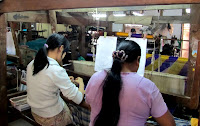2011, DEC17: MYANMAR, AMARAPURA AND MANDALAY
Myanmar is about twice as big as Germany. In ancient times, it was a key land link between traders from India and China, as well as a source of some of its people today.

Majority (65%) are ethnic Bamar. Almost 90% are Theravada Buddhists. Most of them speak the Burmese language, which is a part of the Sino-Tibetan group of languages.
Situated about 600 kilometers north of Yangon on the Irrawaddy River, Mandalay is Myanmar’s
second largest city, and its most reverd cultural and religious centers. It was the capital of the last, independent Burmese Kingdom, which in 1886 was finally conquered by the British colonial forces.
Being surrounded by many former capital of Myanmar, Mandalay area abounds in historical sites, cultural memorials and Buddhist edifices. Primarily pagodas and monasteries still
remain, as most secular buildings of those times, including royal palaces, which had traditionally been built from wood, have disappeared. Many of them were disassembled and construction material thus obtained was use by subsequent Kings to build their own capitals.
Mr. Suday, our local guide, took us directly to Amarapura, “the City of Immortality,” which was King Bodawpaya’s capital, from its foundation by him in 1782 by till 1857, when another King Mindon Min moved the capital to Mandalay.
We went first to the Maha Ganayon Monastery, which is a renowned center for monastic studies.


We watched monks, old and young, moving forward in two lines, at 10:15 a.m. for their day’s only meal.
We also saw where and how the meals were prepared, and the hall where each of them would sit on the floor to consume the food contained three bowls placed on a low-table in front of him.

We also saw where and how the meals were prepared, and the hall where each of them would sit on the floor to consume the food contained three bowls placed on a low-table in front of him.


Before the meal, they take a bath. Some even get their heads shaved.

Our next stop was a weaving factory, known for making traditional wedding clothes for brides and grooms. We were told that it took 45 days to weave a bride’s dress, while only a day to make the groom’s outfit.
As we were getting ready to leave, two nuns came to the factory. Immediately, the owner came out with a food container, from which she doled out some in one nun’s begging bowl. We were told that every day monks and nuns go around town collecting alms from homes and
businesses, and the owners willingly comply.
businesses, and the owners willingly comply.

Labels: 2011, AMARAPURA AND MANDALAY, DEC17, MYANMAR







0 Comments:
Post a Comment
<< Home